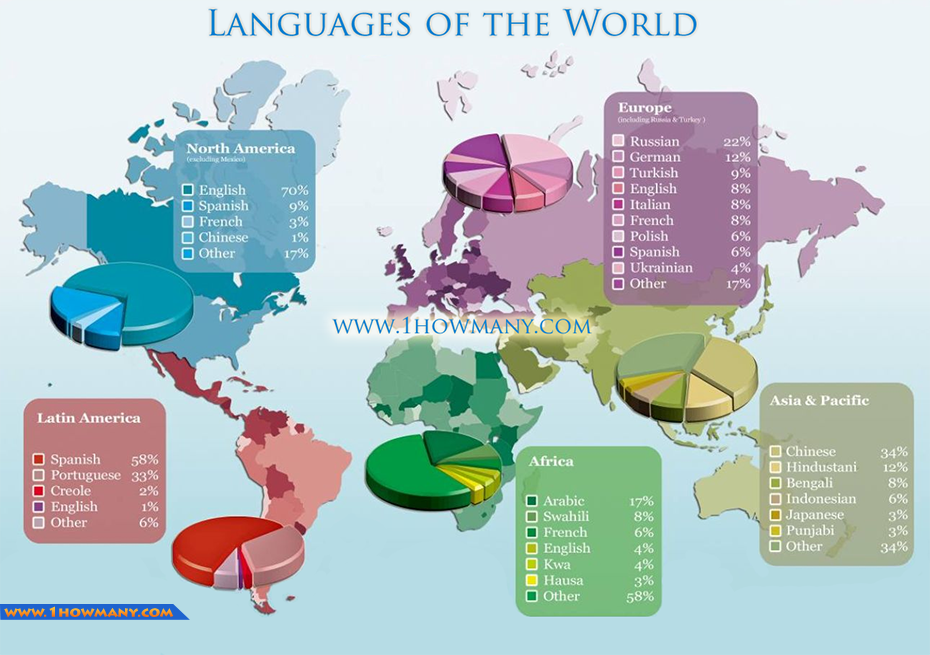The United States has been known worldwide as a melting pot for more than 400 years. The migration of people from West and East alike has created the most diverse culture on the planet. People with roots in nearly every country and region on the planet now reside in the US. They bring with them their traditions and their language. But with perhaps as many as 6,900 different languages spoken worldwide and more than 300 of them commonly spoken in the US, how does a company choose in which other language to do business?
As the map above shows, 79% of the population in the US and Canada speaks one (or more) for only 2 languages. However, if your business resides in a location where a high percentage of the target audience speaks a different language, that should be on the list to consider. For example, in the seven-county San Francisco Bay Area of California, which includes over 7 million residents, over 23% are Asian. This means Japanese, Chinese, Korean, Vietnamese and Tagalog are very commonly spoken languages.
Of course the reason to publish the content of your web site or other collateral materials is to get people to be aware of your company and its product or service. There is a little more to it that just translating the English language content of the parent site’s pages into each target language. We’ve covered some of that in recent blogs. However, when targeting bi-lingual audiences, here are a few things to consider:
Dos
- Choose the right languages for your target audience. If few in your target speak Swahili (the most common language in Africa), don’t waste time and money with a Swahili page.
- Consider the buying process of your ethnic target. In many cultures it is the women who do the research before making a purchase while it is the man who makes the final buying decision. Make sure the messages can be well understood by the reader and that they speak to their needs.
- Make it easy for them to complete the transaction. Some of the ethnic audience may not have US bank accounts required to complete the transaction on your English page. Consider adding other payment options for these customers.
- The importance of alternate language translations increases with the dollar-value of the product or service being considered. This does not mean alternate language pages are NOT important for small value transactions. Simply put, many times more than one person is involved in larger transactions and you want to make sure all parties can understand your value proposition.
- Make sure any slogans, advertisement copy, colloquial phrases and slang is properly translated. This can require some interaction with your language service provider to select the best translation to get your message across.
Don’ts
- Treat your perspective client like a foreigner. They live in your country and have most likely become familiar with basic customs and phrases.
- If you sell your product by the pound, foot or gallon, there is no need to provide conversions to other units.
- They understand the use of holidays to offer discounts. It is not necessary to explain why you are having a Mother’s Day sale on ladies dresses. Nor is it necessary to explain commonly used sales phrases like down payment, lease, discount or others.
- They understand what common phrases mean, such as SUV, King Size, or compact. However, when there is a likely question about some detail of this word, it is a good idea to provide that in advance, such as including the dimensions for King Size mattresses.
- Appear to speak their language if you don’t! If you encourage people to contact you, make sure they understand in which languages you can converse. It is one thing to offer information in another language to help people make a decision but quite another to conduct the on-line, over-the-phone or in-person sales process.
- Use too many slang words in your copy. These typically don’t translate well and can lead to a lot of confusion.
- Don’t over-simplify things for the Ethnic audience. Especially if your product or service has a technical element, you need to provide the complete feature and benefit set in all languages. For many, technical terms in English are just fine when considering which product to buy.
Following these simple Dos and Don’ts will help you avoid confusion in your audience and increase the likelihood of them completing the transaction. As always, this process of creating content in other languages is best done with the help of trained linguists with experience in your industry or market. They know what phases and tactics work for each audience.

